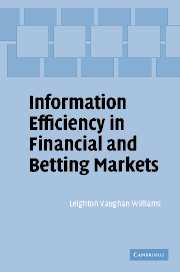Book contents
- Frontmatter
- Contents
- List of figures
- List of tables
- List of contributors
- Introduction
- Part I The concept of information efficiency
- Part II Selected readings
- 4 An assessment of quasi-arbitrage opportunities in two fixed-odds horse-race betting markets
- 5 The presence of favourites and biases in bookmakers' odds
- 6 Searching for semi-strong form inefficiency in the UK racetrack betting market
- 7 Models, markets, polls and pundits: a case study of information efficiency
- 8 Longshot bias: insights from the betting market on men's professional tennis
- 9 Biases and insider trading in exotic bets on thoroughbreds
- 10 On the improbability of information efficient parimutuel betting markets in the presence of heterogeneous beliefs
- 11 Modelling gambling demand in a laboratory casino: discovering the importance of individual-specific effects
- 12 Market efficiency of the 50–30–20–10 horse-racing spread betting market
- 13 Insider trading and bias in a market for state-contingent claims
- 14 Rationality and efficiency in lotto games
- 15 Efficiency of the odds on English professional football matches
- 16 Modelling distance preference in flat racing via average velocity
- 17 Testing for market efficiency in gambling markets: some observations and new statistical tests based on a bootstrap method
- 18 Information (in)efficiency in prediction markets
- Index
- References
17 - Testing for market efficiency in gambling markets: some observations and new statistical tests based on a bootstrap method
Published online by Cambridge University Press: 09 July 2009
- Frontmatter
- Contents
- List of figures
- List of tables
- List of contributors
- Introduction
- Part I The concept of information efficiency
- Part II Selected readings
- 4 An assessment of quasi-arbitrage opportunities in two fixed-odds horse-race betting markets
- 5 The presence of favourites and biases in bookmakers' odds
- 6 Searching for semi-strong form inefficiency in the UK racetrack betting market
- 7 Models, markets, polls and pundits: a case study of information efficiency
- 8 Longshot bias: insights from the betting market on men's professional tennis
- 9 Biases and insider trading in exotic bets on thoroughbreds
- 10 On the improbability of information efficient parimutuel betting markets in the presence of heterogeneous beliefs
- 11 Modelling gambling demand in a laboratory casino: discovering the importance of individual-specific effects
- 12 Market efficiency of the 50–30–20–10 horse-racing spread betting market
- 13 Insider trading and bias in a market for state-contingent claims
- 14 Rationality and efficiency in lotto games
- 15 Efficiency of the odds on English professional football matches
- 16 Modelling distance preference in flat racing via average velocity
- 17 Testing for market efficiency in gambling markets: some observations and new statistical tests based on a bootstrap method
- 18 Information (in)efficiency in prediction markets
- Index
- References
Summary
Introduction
There have been numerous empirical analyses of the efficient markets hypothesis when applied to gambling markets (see, e.g., Sauer, 1998, and Vaughan Williams, 1999, for recent comprehensive surveys). The literature suggests that the null of market efficiency – at least where risk-neutrality is assumed – can be consistently rejected in three major areas of research application. However many of the rejections of the restrictions, required by the efficiency hypothesis, that are reported in the literature are based on classical least-squares regression procedures even though the regression residuals exhibit sometimes very pronounced deviations from normality and heteroscedasticity. As a consequence the inferences based on classical methods are suspect as the true size of the relevant test statistics is not the one hypothesised. Our purpose in this chapter is to reconsider some of the violations of efficiency, employing recently suggested bootstrap estimation procedures which allow for heteroscedasticity and any non-normality in OLS regression residuals. The procedures we employ might be found useful by other researchers in the area. At least they allow for more robust statistical inference than has hitherto often been the case. The chapter is organised as follows. In section 17.2 we first set out the wild bootstrap and then apply the wild bootstrap on a variety of datasets (sections 17.3 - 17.5). Section 17.6 draws some conclusions.
The bootstrap methods, statistical inference
Recent advances in computing offer an alternative approach to hypothesis testing when the error term in a regression is heteroscedastic and potentially non-normal.
- Type
- Chapter
- Information
- Information Efficiency in Financial and Betting Markets , pp. 346 - 365Publisher: Cambridge University PressPrint publication year: 2005
References
- 1
- Cited by



